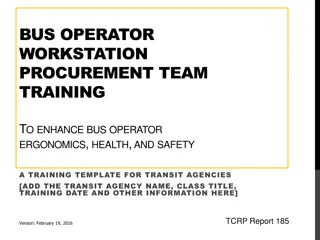Understanding Ergonomics for Construction: Preventing Work-Related Injuries
Ergonomics for construction focuses on fitting workplace conditions to workers' capabilities, aiming to prevent Work-Related Musculoskeletal Disorders (WMSDs). OSHA mandates employers to provide a safe workplace, reducing costs associated with WMSDs and promoting productivity. By recognizing hazards, implementing ergonomic solutions, and sharing ideas, WMSDs can be effectively prevented in the construction industry.
Download Presentation

Please find below an Image/Link to download the presentation.
The content on the website is provided AS IS for your information and personal use only. It may not be sold, licensed, or shared on other websites without obtaining consent from the author. Download presentation by click this link. If you encounter any issues during the download, it is possible that the publisher has removed the file from their server.
E N D
Presentation Transcript
ERGONOMICS FOR CONSTRUCTION
Ergonomics Ergonomics is defined as the science of fitting workplace conditions and job demands to the capabilities of the working population.
Translates to: Changing the way we work to prevent injuries. Analyze the way construction was done in the past and change the way we can accomplish the same tasks today with less injuries.
What type of injuries are focused on? Work Related Musculoskeletal Disorders or WMSD Muscles Joints Nerves Ligaments Tendons Cartilage Spinal Disc
How does OSHA provide ERGONOMIC protection? OSHA relies on the General Duty Clause , which requires employers to provide a safe and healthy workplace that is free of recognized hazards.
Work-Related Musculoskeletal Disorders (WMSD s) Cost businesses billions of dollars each year Lost time injuries Decreased productivity Absenteeism Insurance Claims - Worker Compensation, Premiums
Cost of Injuries (U.S. Bureau of Labor Statistics) 650,000 WMSD s cases $ 20 Billion Dollars Worker Compensation and Medical Expenses $1 of every $3 of worker compensation costs are spent on Occupational MSD s
Leading types of Workplace Injuries Lost time Injuries Sprains/Strains 38.0% Cuts /Lacerations 11.70% Fractures 10.20% Multiple Injuries 3.20% Bruises/Contusions 7.50% All Other 29.40%
How can WMSD be prevented? First you must recognize the hazard in the work task. Think about the tasks that are uncomfortable or difficult to perform. Try solutions (work tasks, tools, or equipment) to make the tasks easier to perform. Share your ideas and ask other for ideas.
Common Ergonomic Hazards that may occur in the work activities 1. Repetition involves doing that same task repeatedly (every few seconds)that uses the same muscles over and over and for long period Fatigue, muscle-tendon strain can accumulate
Common Ergonomic Hazards that may occur in the work activities 2. High Force using high muscle power during activities, such as heavy lifting, pushing items or gripping tools.
Common Ergonomic Hazards that may occur in the work activities. 3. Awkward Postures working with your body held in a poor position for a long periods of time and the amount of force or stress that is generated or tolerated.
Common Ergonomic Hazards that may occur in the work activities 4. Contact Stress repeated or continuous contact pressure from sharp objects pushing on the soft body or hand tissues.
Common Ergonomic Hazards that may occur in the work activities 5. Vibration exposure to local vibration that occurs when a specific part of the body or the whole body comes in contact with vibration from power tools or equipment.
Common Ergonomic Hazards that may occur in the work activities 6. Duration the amount of time a person is continually exposed to a risk factor or multiple risk factors
Other Ergonomic Hazards that may occur in the work activities. Cold temperatures Insufficient pauses and rest breaks for recovery Work pace (machine speed) Unfamiliar or unaccustomed work
Common Repetitive Strain Injuries Injury Symptoms Risk Factors Carpal Tunnel Syndrome Pain, numbness, tingling in hands, weakness and clumsiness of the hands Swelling that forms a lump on the wrist Repetition, working with wrist bent, and/or forceful hand movements Repetition of working with wrist bent Ganglion Cysts (Bible Bumps) DeQuervain s Disease Pain and inflammation at the base of the thumb Repetition of a clothes wringing motion (e.g. Nippers/Pliers) Forceful Gripping, vibration, extreme cold and/or wet environment Raynands Syndrome (White Finger) Loss of control and feeling in fingers and hands, numbness or tingling in the fingers Pain or inflammation of the palm side of index finger Trigger Finger Forceful gripping of hard/sharp edges , repetitively or constant
Common Repetitive Strain Injuries Injury Symptoms Risk Factors Tennis Elbow (Epicondylitis) Pain and inflammation in elbow Repetition, rotation of forearm, or force Tendinitis Pain and Inflammation in any joint, such as elbow, knees, wrist, etc. Pain and restricted motion in shoulder, may lead to arthritis Repetition and awkward positions or posture Repetition, overhead work, or working with arms in winging motion Repetitive lifting, pulling, pushing, bending, and twisting Rotator Cuff/ Tendinitis Herniated disc or slipped disc Pain and restricted motion caused by pressure on nerves in lower back or lumbar region
How can these injuries be reduced or avoided? A. Know your job or task Think about what you will be doing. Use the tools designed for specific purposes. Wrong tool often damages the tool or can cause pain, discomfort, or injury. Select the proper tool for the task at hand.
How can these injuries be reduced or avoided? B. Look at your work space Awkward positions may cause the need for more force. Power grip versus pinch grip tools (finger twist vs. hand torque.
How can these injuries be reduced or avoided? C. Improve your posture/position Avoid awkward positions. If you are sitting stand. If you are standing reposition your work piece. Or work on a lower or higher work surface. Lift with the load close to your body.
How can these injuries be reduced or avoided? D. Select the proper tool Choose the tool for the job for which it was designed for. Long-handled tools have more leverage. Short-handled tools keeps the wrist straight. Use tools that put less pressure on tissue and muscles.
Proper tools avoids injuries. Carpal Tunnel Syndrome- working with bent wrists; a high rate of repetition using the hands; a lack of rest for the hands and wrists; forceful hand motions.
Selecting tools to avoid injuries. Choose a tool with a comfortable handle diameter. 1 to 2 inches for single handled tools.
Selecting tools to avoid injuries. For double handled tools (plier-like). Select the tool with a grips span of at least 2 when fully closed and no more than 3 when fully opened. If continuous force is required consider using a clamp, grip or locking tools.
Selecting tools to avoid injuries. Select tools with out sharp edges or finger grooves on the handle. Select tools that are coated handle with a soft material.
Selecting tools to avoid injuries. For doubled handed pinching, gripping, or cutting tools; select tools with handles that are spring loaded or tools that return to the open position.
Selecting tools to avoid injuries. Select tools with an angle that allows one to work with a straight wrist. Tools with a bent handle are better than with a straight handle when force is applied horizontally.
Selecting tools to avoid injuries. Select tools with an angle that allows one to work with a straight wrist. Tools with a straight handle better than bent handle when force is applied vertically.
Selecting tools to avoid injuries. Select tools that can be used for the dominant hand or either hand Select tools with non-slip surface for better grip. Sleeves always increase the diameter or the grip span of the handle.
Selecting tools to avoid injuries. For tasks requiring high force. Select tools handles that are longer than the widest part of the hand- usually 4 to 6 inches. Prevent contact pressure by making sure the end of the handle does not press on the nerves and blood vessels in the palm of the hand.
Todays Safety Concerns Forceful exertions Increased weight of a load Increased bulkiness of loads Use of an awkward positions Speeding up of movements Increased slipperiness of an objects handled (which requires grip force) The presence of vibration Use of small or narrow tools
Recognize the Hazard Discuss some of the possible solutions
Symptoms of WMSDs may not appear immediately. They develop over time, weeks, months, or years, by then the damage may be serious. Take preventative action before you notice the symptoms. Life is a matter of endurance. You only have one body make it last.























